Nutritional Enrichment and Your Dog’s Instincts
Nutritional enrichment enhances your dog’s quality of life by incorporating food into their natural instincts to seek, forage, find, sniff, hunt, taste, lick, and chase. Similar to the way a piece of cake in the refrigerator excites and satisfies us, the same hit of neurotransmitters is experienced by your dog when they detect the presence of food. Even the least food-motivated dogs have their interest piqued knowing that a tasty treat is out there for the taking.
Importance of Your Dog’s Sense of Smell
Dogs rely heavily on their sense of smell, making it their most dominant sense. You can engage your dog’s sense of smell by introducing new food reward toys, puzzles, and games. Start slow – it’s important to remember that just like you wouldn’t expect a new puppy to immediately understand that outside is for potty, introducing toys that require some degree of brainpower should be done gradually, ensuring success rather than frustration.
Try leaving a soft toy overnight in a container of shredded cheese or dried beef jerky. The next day, the toy will smell delicious to your pup. Hide the toy under a dish towel and observe if they try to nudge the towel aside to get the reward, discovering the toy’s secret location. If not, lift the towel and reward their interest with praise and a treat.
Toys for Nutritional Enrichment
The most popular toys that provide nutritional enrichment dispense treats or food.
Rolling balls with small openings for kibble require your dog to smell the food, then push the toy with their paws or nose to allow a treat to come out. You can adjust the difficulty.
Rubber Kong toys can be filled with snacks like kibble, bananas, rice mixtures, or moistened kibble, then put in the freezer. Frozen treats delay the reward, and sniffing, licking, and manipulating the toy provides enrichment.
Lick mats and silicone pads with nubs or crevices can stimulate your pup. You can smear some peanut butter or plain yogurt or top them with low-sodium chicken broth and freeze them.
Puzzles that require sliding panels, flipping open doors, or checking fleece pockets for kibble are meant for highly intelligent dogs like Border collies, pointers, shepherds, and some terriers that might need this extra stimulation!

Easy DIY Dog Toys and Games
Some of the most creative and cost-effective enrichment ideas come from pet owners themselves.
Upcycle your Amazon boxes by hiding treats inside and letting your dog roll, chew, and toss the box for their reward. As they become more adept at the game, increase the challenge by placing boxes or cardboard towel rolls around the house filled with kibble for an interactive hide-and-seek hunt or nest boxes of decreasing size with the treat in the smallest box.
Make pupsicles using canned pumpkin, pureed veggies, or broth for a refreshing treat on hot days. For smaller pets, use an ice cube tray instead.
Hide kibble in muffin tins or empty egg cartons and cover each compartment with an unbreakable object like a tennis ball or cup. Your pet must use their mouth or paws to uncover the food.
Create a snuffle mat from an old felt blanket or towel by cutting it into strips and tying them to a rubber bathmat or dish drainer. Hide bacon-flavored treats or freeze-dried fish in the felt strip “lawn,” and watch your dog sniff, dig, and forage for their reward.
Use multiple food bowls to feed your dog their nightly meal. Vary sizes and shapes to keep mealtime fun and stimulating.
Bury food rewards in a basket filled with soft toys, pillowcases, or towels. Perfect for those days when your pup needs some mental stimulation but you need a break.
Keep Track of Calories
Every meal and snack presents a chance to improve your dog’s nutrition. Even though the experience of seeking and eating food is enjoyable, it’s essential to keep track of calories. Beginning your day with a pre-measured bag of kibble and treats to use with toys or games is good practice. Food enrichment toys are handy when the weather is unfavorable or you have a long workday. Don’t forget to balance your dog’s calorie intake with appropriate physical activity.
Nutritional enrichment helps support a healthy lifestyle for your dog by stimulating their innate tendencies, providing mental stimulation, and encouraging bonding. And remember, it’s all about having fun!
View our Pet Wellness Videos for more expert pet advice.
At Pet Butler, we want you and your pet to live your best and healthiest lives, which is why we offer pet waste removal and other services year-round. We offer weekly, bi-weekly, monthly, and one-time clean-up services to meet your schedule and needs.




